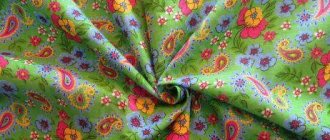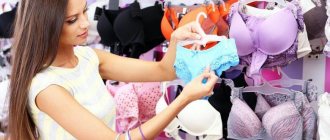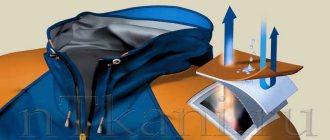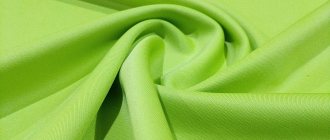What kind of fabric is this, characteristics
This is a completely natural product, lightweight, does not interfere with the skin's breathing, does not restrict movement and is safe. It is made pure, without adding dyes. There are options with smooth coloring or printed designs. The material belongs to the cotton category.
Production, composition, finishing of cotton
Chintz is natural, it is made from cotton that is completely cleaned and prepared for carding. It is also called raw cotton. During production, the material is additionally cleaned and loosened. After carding, it is bleached so that the fabric turns out white and not gray. After this, weaving of the threads themselves begins, or dyeing them in a different color. The process is simple, which allows factories to save money and offer affordable prices for products.
Read the description and properties of fabric for sewing table accessories - Zhuravinka here.
It can be completely divided into 6 stages:
- Cleaning, combing, sorting.
- Uniform fibers are woven into a thread.
- Weaving the fabric with simple weaving.
- Bleaching the fabric itself.
- Painting or adding a design.
- Bringing to marketable condition: trimming, smoothing.
At the bleaching stage, the material is treated with a solution containing sodium. This makes it stronger and also gives it an interesting shine.
Texture and density (description of what it looks like)
Due to the fact that kanji consists entirely of cotton fibers, it is durable and at the same time soft and pliable. The density is at the level of 80-100 grams per meter. The material does not retain heat well, which is why products made from it seem cool. To the touch you feel that the canvas is inexpensive, but still pleasant. There are no special features in the structure. This is a regular fabric without scars and pile, unlike poplin.
Properties of cotton material
The full list of advantages and features looks like this:
- strength due to the material of manufacture;
- ease of use;
- ease of wearing;
- ease of processing;
- price;
- environmental friendliness - no synthetic impurities are added during production;
- paint fastness when washed, it does not fade, does not fade;
- crease resistance;
- hypoallergenic, recommended for use by children;
- pleasant coolness in the hot season, like cambric;
- ease of care.
These are the main positive properties. Despite this, there are some shortcomings. They include:
- fragility - over time, the fibers will wear off with intense wear;
- high temperature is destructive;
- after washing the product may shrink;
- instability to creasing.
Photos of single bedspreads for the nursery can be viewed at the link.
Fragility is an individual concept. The average lifespan of a chintz item without problems is 2 seasons. For many people this will be enough.
Description of calico and chintz
Chintz is the most popular fabric from the cotton group. The material is obtained by special finishing, dyeing of plain calico, which, in turn, is woven from a mixture of long and short thick fibers in a plain weave. The weft and warp fibers do not fit tightly together, so the fabric turns out thin, with a slightly sparse structure. There are from 30 to 40 threads per 1 cm2.
Chintz has all the properties of natural fabric: it allows air to pass through well, absorbs moisture, and does not cause skin irritation.
Important. According to the latest GOST conditions, chintz may contain polyester fibers.
It lends itself well to coloring and processing. Types of chintz:
- plain painted;
- printed
- polished;
- embossed;
- header (crash).
Fact. Chintz has a firmly established reputation as a “fun” material, since the front side is traditionally decorated with bright floral patterns.
Calico is also made from cotton yarn, but from more twisted threads. The fabric is produced using a special plain weave: the weft and warp fibers not only alternately intertwine each other, but also additionally overlap every two steps.
Calico differs from calico in the density of the fibers: per 1 cm2 there are from 46 to 64 threads. The fabric is denser, almost does not wrinkle, and repels dirt well.
The material has a matte, rough surface. The fabric is soft and flexible to the touch. Exhibits properties characteristic of a natural composition: breathability, hygroscopicity, safety.
Varieties:
- harsh;
- bleached;
- smoothly painted;
- printed;
- medical.
In addition, upholstery and technical materials are produced. Textiles are made from coarse fibers with the most dense weave.
Important. According to Russian GOST, calico should consist of 100% cotton. Turkish and Pakistani manufacturers have less stringent regulations, so most imported fabrics contain up to 15% polyester or polyester.
Types: printed, polished, madapolam, unfinished
The canvas can be of 4 types. The differences between them are minor. But it’s worth considering these options separately.
- Printed. The so-called “grandmother’s” chintz or Soviet. So it is called for its texture - untidy, not factory-made. The design is applied on top of the finished material. The latter is not cleaned to blinding whiteness, but remains gray. Despite this, the view is one of the most popular.
- Polished. A variety in demand for its strength. This is the most wear-resistant version of chintz of all. But such qualities have their negative sides - the material is rough and hard, which is why clothes cannot be made from it. But curtains for the kitchen, upholstery or interior items turn out beautiful and durable.
- Madapolam. This variety is considered a separate, independent fabric, but this is not so. A distinctive feature is increased rigidity. It is achieved through finishing and starching of the finished fabric after washing. All other properties are similar.
- Rough. Calico is a well-known name for this species. It is an unprocessed, only manufactured material. Used as a blank for other fabrics. However, it can also be used independently. The grayish tint gives things a special look. You can find upholstery for furniture, bedspreads for sofas, beds, and armchairs from calico. Find out about which fabric is best to choose for furniture upholstery in this article.
What is chintz
This is the name of a fabric in which one side is decorated with a pattern, which in ancient times was printed on it by hand. With the advent of high-performance machines in the textile industry, designs began to be applied mechanically. This fabric is called printed. The roots of this production stretch from ancient India, where there was enough cotton and natural dyes.
Chintz
One of these fabrics was chintz. This is a light cotton fabric of special manufacture, which is used for sewing bed linen, men's shirts and summer outerwear. It was used to decorate interiors and upholster furniture. Since the 17th century, chintz began to spread throughout Europe, where workshops for printing designs on fabric appeared. Over time, England and France developed their own production of printed fabrics. In Russia, from the end of the 18th century, Ivanovo became the center of chintz production, where there is a chintz museum today. A tradition arose to celebrate the first anniversary of marriage, which was called a calico wedding.
This popular fabric is characterized by thick threads with a relatively sparse weave. Its density is in the range of 80-100 g/m2 . There are 30-40 threads per square meter. Due to its low density, it is softer. Its shrinkage can be up to 5 percent. Wear resistance is not great, it can withstand up to hundreds of washes. Accordingly, the price is affordable. More often it is fermented using a less expensive surface method, when paint is applied to the woven fabric. This is a printed design. Chintz is comfortable to wear, very light and hygroscopic, preferable for summer clothing.
There are various types of it. So, underwear, shirts and pajamas are sewn from plain-dyed. When washed in moderately hot water, its colors are well preserved. The most durable chintz is polished. It almost does not tear and is hard to deform. Well suited for furniture upholstery and curtains. Printed chintz can be embossed using “hot” technology. It is used to make tablecloths of extraordinary beauty and high-quality wallpaper. Decorative corrugated chintz serves as a wonderful material for women's sundresses and blouses. He is able to visually enlarge the figure.
Application
The list includes different options for using the fabric:
- pajamas;
- home casual wear;
- baby diapers;
- curtains;
- potholders;
- towels;
- tablecloths;
- pillows;
- pillowcases;
- bed sheets;
- furniture upholstery;
- chair covers;
- Men's shirts;
- dresses;
- sundresses;
- skirts;
- blouses.
The list goes on, chintz is universal and suitable for any task. When sewing light dresses and sundresses, chintz is the best choice of fabric for a dress.
Production Features
izdelie-2
izdelie-4
Chintz is made from natural cotton using plain weave. Previously, the Surat species was often used for production. It has a medium thickness and twist.
Standard thickness is from 80 to 100 g/m. Plain weave is the simplest. One warp thread corresponds to one weft thread. The manufacturing process is as follows:
- Procurement of raw materials. First you need to collect raw cotton. It is cleaned and prepared for carding.
- Carding includes: loosening, mixing, fraying and cleaning. Debris is removed from the raw material, it is combed out and bleached.
- Once the fibers are clean and uniform, they are dyed or woven into fiber. Typically, “surface” dyeing is used for chintz, that is, the design is printed on the finished fabric, rather than the fibers being dyed
Plain weave is also considered the most durable. The weft thread overlaps every other warp thread. It refers to the main weaves. As a result of its modification, patterns are obtained. You can easily see the even and odd warp threads on the fabric. This fabric is usually produced on machines with 2 and 4 healds.
Chintz is dyed using the printed method. This method originated in India. Initially it was “manual”, so the price was far from budget. In order to apply the image, blank boards were made. They were usually made of wood. The required pattern was stamped on them. The areas that were to be painted were filled with paint. Then fabric was placed on the boards, and the surface was tapped with hammers.
Currently, the printing method has moved from the category of manual labor to machine labor, but the principle remains the same. Moreover, the first steps in this direction were taken at the end of the 18th century in Switzerland.
Care
The material is unpretentious, so there will be no problems with care. However, the following points should be taken into account to make things last longer:
- After purchase, it is recommended to wash the item with cold water acidified with lemon juice. It is better to do this with your hands, and there should be a little juice so as not to lose color. This procedure will add softness and strengthen the paint.
- After washing, the product must be dried flat. Should not be placed near heating appliances.
- The washing temperature depends on the type of material. Printed and smooth wool are washed at no more than 50 degrees. Before you start, you need to turn them out. Unpainted items can withstand boiling water.
- When cleaning, do not use bleach or powder with a high content of bleaching substances.
- It is better to iron using a steam generator; an iron with a steam function is suitable. If it is not there, then before ironing the product must be moistened with water using a spray bottle.
These are general rules. Before use, you need to look at the label, which contains recommendations from the manufacturer.
Read about the types of Calico fabric in this material.
Is there a difference
Chintz and calico are quite popular cotton fabrics and have many advantages. However, there are some differences between them.
- Chintz is softer than calico, which makes it preferable for children.
- Calico has a wider range of applications than calico.
- Calico is a denser material than chintz.
- Compared to calico, chintz is less durable; after a year or two, products made from it lose their shape and brightness of color.
- After washing, chintz shrinks less than calico.
ProductsComment
What is the difference (differences, difference) between chintz and calico and satin
Situations arise when these three materials are confused with each other. They're actually similar, but it's not hard to tell the difference if you know what to look for.
Calico differs from calico by its weaving. The first is denser, stronger, tougher. When weaving, additional overlap is used, repeated through the plexus. Average density - 130 grams per square meter.
The difference from satin is even easier. This is an expensive material, its structure resembles silk, delicate, soft, shimmers in the light. It is also noticeably denser than chintz. The main difference will be the price. In the store, satin is more expensive than chintz.
Read reviews about polysatin bedding here.
About cotton fabrics
Cotton fabrics are made from fibers that are located on top of the seeds of the annual cotton plant. This valuable plant is grown in many Asian countries.
Cotton
Cotton fiber is, in fact, natural cellulose, which serves as the basis of many fabrics. Cotton is pleasant to the touch, slightly rough, dry and warm. It conducts heat poorly due to the fact that the fiber is a hollow tube, repeatedly curled around its axis. The strength of the fiber increases as it matures and the deposits of cellulose, which makes up 95% of it, increase. Its fibers can have different lengths and thicknesses and different degrees of hairiness, which makes it possible to produce a wide range of cotton fabrics. They are not always made from pure cotton.
Cotton fiber
Often, to improve consumer properties, other threads are added to cotton threads. These can be artificial fibers such as polyester or lycra. Such fabrics can have different purposes and differ in the type of yarn, its thickness, finishing and type of weave. So, for sewing shirts, dresses and bed linen, chintz, calico, satin and other materials can be used. This happens because, due to its hygroscopicity, cotton removes excess moisture from the human body. At the same time, the fiber, swelling, becomes almost 40% larger in volume. However, the strength of wet cotton fabric increases noticeably.
On the other hand, it allows free air penetration, helping to ensure an optimal ratio of dry air and humidity at the surface of the human skin. This is a highly hygienic material that does not cause discomfort, allergies or irritation. Therefore, it is suitable for everyone, especially people with skin diseases.
Along with the advantages of cotton fabrics, most of them wrinkle easily. As a result, the appearance of a product made from such material is lost. They tend to shrink after the first wash and dry slowly. Cotton fabrics reduce their strength in light and with prolonged heating and can rot.
Characteristics of chintz
Chintz, what kind of fabric is this? This is a material with a density of 80g/m² - 100g/m², which makes it soft, weightless and pliable. Fresh woven material is white, but can be easily dyed with natural and synthetic dyes. Real chintz smells like burnt paper when burned.
pros
The advantages of chintz include:
- environmentally friendly - the fabric is safe for both children and the environment;
- unpretentiousness and ease of care - it is easy to wash, dry and iron, and storage does not require special conditions;
- comfort - the body in cotton clothes breathes, the fabric absorbs excess moisture;
- brightness - a huge palette of colors and shades is characteristic of it.
Helpful information:
Footer with lycra what kind of fabric
What kind of fabric is poplin?
Minuses
The disadvantages are the following characteristics:
- Easily wrinkles;
- It breaks quite easily.
Types and applications
Calico can be different. It differs in density and composition, as well as in the type of coloring. There is undyed or raw calico, bleached calico, plain-dyed, and printed. The parameters and purpose of the main varieties are presented in the table.
| Calico | Appearance | Strength | Coloring | Application |
| Harsh | Hard, rough to the touch, with a creamy tint | Maximum | No | Manufacturing of work overalls, furniture upholstery |
| GOST calico (bleached) | Nice texture, light fabric | High | Different colors | Sewing casual and medical clothing, textiles for hotels and restaurants |
| Plain painted | Material, pleasant to the touch, bleached | High | One tone | Sewing bed linen, lining material for suits, table textiles |
| Printed | Beautiful fabric with a colorful pattern | High | In different colors | Used for sewing adult and children's bed linen, pajamas, women's dresses |
Depending on the density, calico calico is distinguished: luxury, standard, comfort, light, biomatin, ranfors. To produce luxury calico, thin, strong threads are used. This is an improved quality cotton fabric with a density of 125 g/m2. Pleasant and smooth to the touch, practically no pellets form on it. It has a more delicate texture compared to regular calico. Therefore, it is suitable for sewing children's sets: borders, discharge envelopes, nests. The material is used to make shirts, skirts, dresses, textile decor, and interior dolls.
Ranfors is a dense fabric with a silky texture and softness. It is wear-resistant and can withstand up to 300 washing cycles. The material is easy to paint and has high hygroscopicity. Doesn't roll, doesn't fade, doesn't wrinkle. A bed made from calico-ranfors is recommended for people with sensitive skin and allergies, as the fabric has antibacterial and antifungal properties.
What is it made from?
The properties of chintz make it an excellent fabric for sewing summer clothes. What is most often sewn from it?
- dresses, light sundresses;
- light shirts;
- home suits;
- pajamas;
- curtains;
- tablecloth;
- diapers for children;
- dressing gowns;
- pillows;
- pillowcases, covers;
- nose caps.
To decorate rooms in the Provence design, chintz materials are often used: for pillowcases, pillows, cozy curtains, neat tablecloths for tables. The photo shows suitable examples.
Kinds
Chintz is not a monotonous fabric, but has several varieties. Each type has its own characteristics.
Plain painted
This type of cotton fabric is dyed the same tone on both sides, so it is impossible to determine the “face” and the back. There are no color restrictions today. It is sold in rolls 0.8 meters wide. Scope of application: sewing plain clothes (shirts, chemises), room decorations and handicrafts.
Polished
The most durable and wear-resistant type of chintz. It is almost impossible to wrinkle, difficult to tear or deform, but there is a downside to such excellent qualities. Polished chintz is very hard and unyielding for use in tailoring. Therefore, its main purpose is curtains for windows or upholstery. In this environment, the qualities of chintz are revealed best. This type has no restrictions on color and design.
Printed
Printed chintz is a poorly cleaned grayish fabric, on top of which a multi-colored pattern is applied. Its purpose is decorative, but not in an aggressive environment. The material will not withstand crushing and rubbing well.
Embossed
This type of fabric is used to make expensive wallpaper and fine tablecloths. A pattern of any color and complexity is applied to the canvas using hot stamping. The perfectly straight and even material looks great on the walls or on the table.
Reaper
This type of chintz received its name due to its wrinkled texture. Fabric of any color with a ruffled effect is great for light sundresses and blouses for teenage girls.
Belozemelny
This is a bleached material onto which a design or pattern is applied. White earth chintz is used to make bed linen, scarves, diapers, scarves, dresses, robes and other things.











